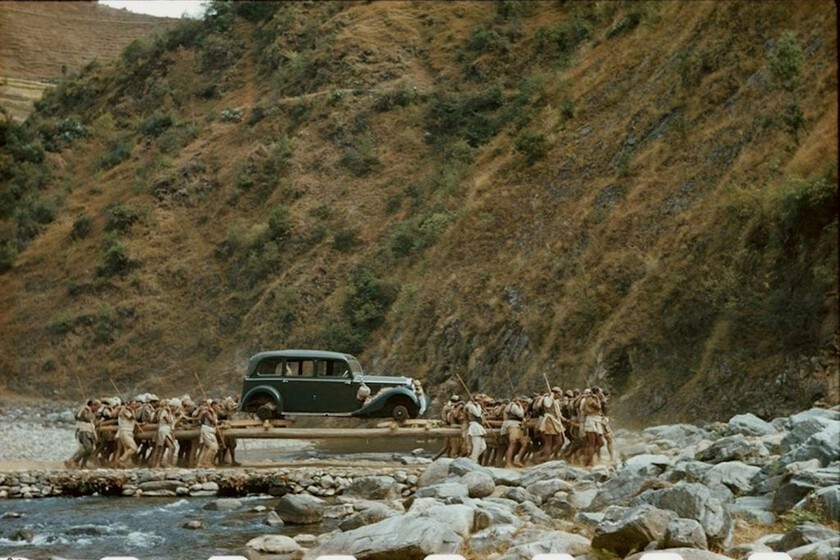
The image we open with is completely real. The scene took place in the Chitlang Valley, located on the ancient route known as the “Road of the Rolls Royce”which already gives us a clue about the enclave. In the past, a testament to human ingenuity and resilience in the historical context of Nepal. However, the curious thing about what we see is not only that a hundred people carry a car on their shoulders, the original owner of the vehicle made everything a little more surreal.
Without roads there are no cars. For decades, the famous road was a trail very popular for vehicle transportationthe only “road” that was used before the construction of modern roads. With no cars running, vehicles were disassembled and loaded onto bamboo poles and carried on the shoulders of dozens of porters.
That route was an essential link between the Kathmandu Valley and the Terai plains, in addition to being traveled by merchants, pilgrims, foreign and local dignitaries for centuries. In fact, until 1956 the cobbled route was the only one that connected Kathmandu with India through that winding route that included crossing forested hills and picturesque villages such as Chitlang, Markhu and Kulekhani. Finally, with the construction of Tribhuvan Highwaythe trail fell into disuse, leaving behind isolated villages and transforming them into silent vestiges of the past.

Hitler and his car. As for the image that has become iconic over time, it appears to have taken place in the 1940s (possibly 1949), although there are several versions about the recipient. The most widespread: Adolf Hitler presented the vehicle to King Tribhuvangrandfather of the last king of Nepal, Gyanendra. None other than a 1938 Mercedes-Benz (a 1937-1939 model 230 Pullman Landaulet).
The car, the first to be seen in the country, was to arrive in Kathmandu at a time when, as we explained, Nepal lacked modern roads. The solution was the one we see in the image, one that would later be repeated with other vehicles, always with groups of Nepalese men physically carrying the vehicle through the difficult mountainous terrain, showing that mix of ingenuity and human effort in the face of adversity.
As we said, there is a second version of the events. In it, it is suggested that the recipient was the Prime Minister of India, Juddha Shumsherwith the intention of gaining the support of Gurkha soldiers in World War II.
The historical role of porters. The truth is that human cargo transportation has ancient roots prior to the domestication of animals and the invention of the wheel. Although it declined with the end of slavery and technological advancement, this method persists in places where mechanical means are not viable, such as mountains, jungles, and hard-to-reach areas.
In the case at hand, in Nepal, this legacy remains alive in the famous “Sherpas”, a name commonly given to the porters of the Himalayas, although originally it refers to an ethnic group adapted to life at extreme altitudes, today They are logistical professionals and essential expert guides in mountain climbing.
Tradition and modernity. The case of the Mercedes-Benz brought to Kathmandu reflects not only a unique moment in Nepal’s history, but also the resilience of mountain communities that, even in the contemporary era, retain essential roles in logistics and transportation in extreme conditions. The emblematic event highlights the human capacity to adapt and overcome obstacles, combining tradition, ingenuity and collective effort.

The “return” of the car. A few years ago it was known that the car was still “life”. It had apparently been repaired and used to take visitors around the grounds of a Nepalese palace museum. Previously, the vehicle had been stored in a former palace garage for more than five years, after being abandoned by an engineering school that I had been using it to teach.
The history of the German company’s car could not be more curious. The car that began carrying Germany’s Nazi leader ended up lost in the mountains of Nepal (an enclave that, by the way, fought against Germany alongside the British) so that the little ones could learn some history.
Image | YouTube (possible attribution to Kurt Wentzel)
In Xataka | The Mercedes T80, the car mounted on the engine of a fighter with which Hitler wanted to reach 750 km/h
In Xataka | Stromlinienrennwagen: the magic word that hides a 1955 Mercedes that flew at 300 km/h and today costs 50 million euros